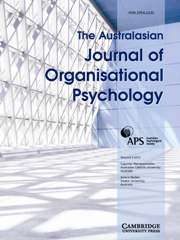Article contents
The Maternity Journey in an Organisational Context: A Case Study
Published online by Cambridge University Press: 14 August 2012
Abstract
The transition to motherhood is a significant life event impacting on all spheres of a woman's life. In an organisational context, changes to women's relationships with their employer and to their social identity occur as they adjust to their new role. A case study was undertaken to describe and compare the workplace experiences of three female employees from one health organisation who were either preparing to commence, currently on or recently returned to work from maternity leave. At all stages of the maternity journey, women expected flexibility from their employer in negotiating their return to work and managing parenting responsibilities. Women's obligations to their employer included being open about their capacity to work and parenting situations which may interfere with their work, as well as maintaining their work performance. Within a supportive work environment that included a shared identity with managers who were also mothers, women's social identity as a worker was not significantly threatened and did not change. Social identity change may be most apparent during the transition to first-time motherhood.
- Type
- Articles
- Information
- Copyright
- Copyright © The Authors 2012
References
- 1
- Cited by




